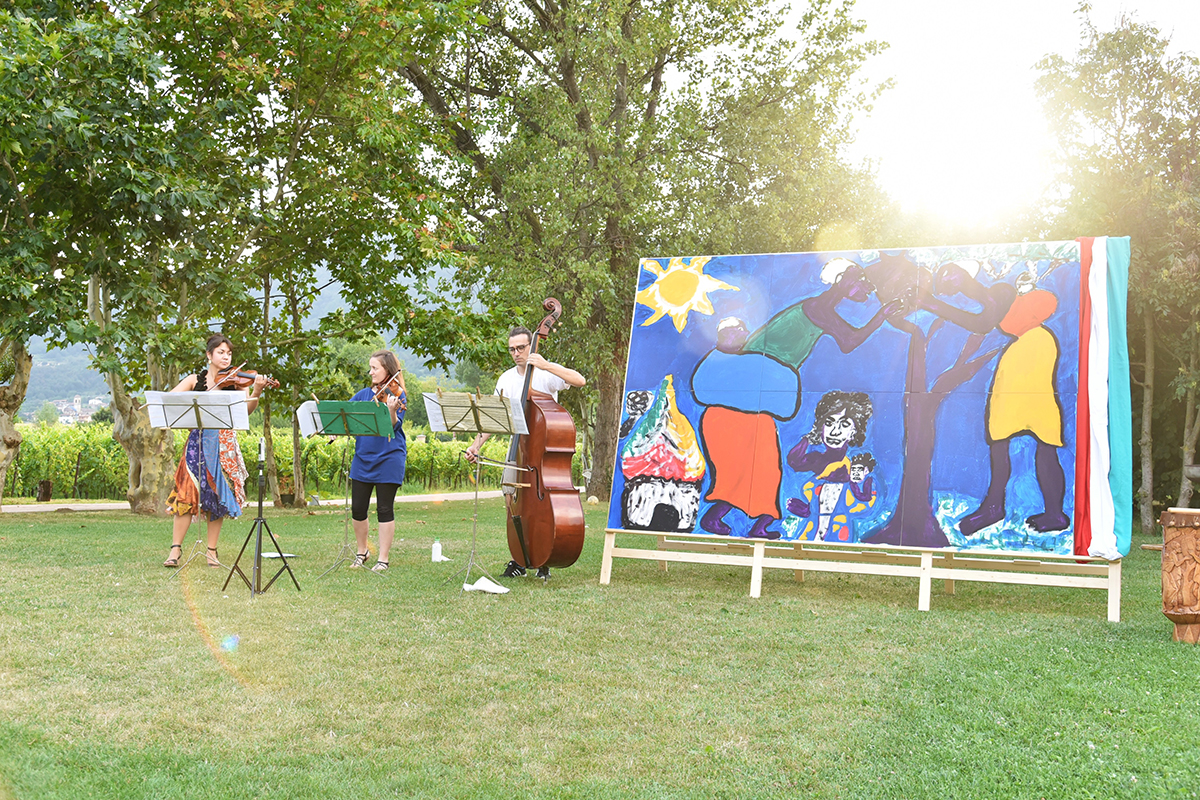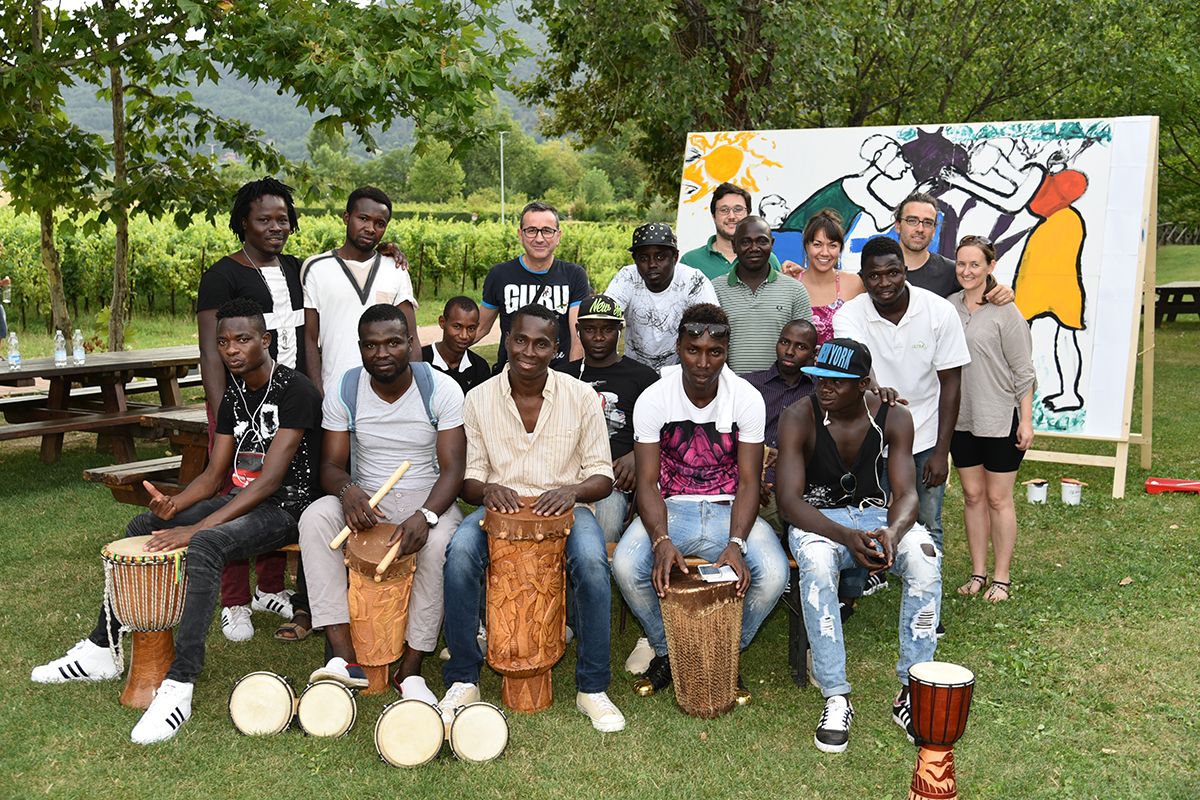'Healing through the arts': Kim presents refugee project
By Daniel Aloi

Violinist and assistant professor of music Ariana Kim found inspiration last year among a group of refugees and asylum-seekers in Italy for “Le storie di vita nel legno” (“The Stories of Life on Wood”). Combining music, visual art and architecture, the project’s U.S. premiere is April 29 at 7 p.m. in Klarman Hall.
The free public presentation features a mural created by refugees and displayed in the atrium. A 45-minute documentary about the project by Italian filmmakers Paolo Piubeni and Simone Mosca will screen in Rhodes-Rawlings Auditorium, followed by Kim, guest violinist Susan Waterbury and cellist Elizabeth Lyon performing trios by Cornell doctoral composer Can Bilir.
For the refugee participants in Italy, Kim said the collaborative humanitarian project represented “a new life, and healing through the arts.”
She had a grant to develop a large-scale project on the theme of empathy for the 2016-17 Cornell Council for the Arts Biennial, and was on academic leave in Italy and thinking of having her project address immigration and the European migrant crisis.
“The more I read, see and hear about … people being pushed from their homeland because of poverty and war, my heart goes out and I feel helpless,” she said. “I wanted to somehow make a difference. Even if it only touched a few lives, even if it is only a drop in the ocean, I wanted in some way to make it meaningful.”
Kim connected with the nonprofit organizations Cooperativa Selene and Periscope for Arts in Brescia, Italy, as project partners. The cooperative serves refugees from North and West Africa, and “provides housing and legal services while they file for asylum,” she said. “In exchange, the group works for the community in a volunteer capacity, maintaining public parks, gardens and roads, while taking weekly classes in Italian.”
The refugees were unmarried men from the Ivory Coast, Libya, Nigeria, Senegal and Ghana, Kim said: “These men are incredible – although they were welcomed, they were still isolated and thought they should stay in their own group. So we started a series of cultural salon evenings, just talking and playing music. We would meet every couple of weeks … I thought through these salons we could get to know them better.
“At one point they said, ‘We love music, too. We grew up with music,’ so, after some exchange in several different languages, we found out they wanted to get some percussion instruments. I found some rattles and drums; we brought these in and their eyes lit up – they were home again. They began jamming and playing for us, and we were playing for them. I started playing a bluegrass tune and they joined in. … Some of them had faced so much tragedy. It was good for them to feel something different.”

Kim commissioned Italian architect Ottavia Lancini to design a wooden structure for a mural the refugees could paint and tell the story of their lives before fleeing to Italy. “They created this abstract expression of their experience. They weren’t artists but knew what they wanted to do,” she said.
She asked associate professor of music Kevin Ernste about student composers for the project, and Bilir, who is from Turkey, showed interest and was commissioned to compose three new works.
“He tried to capture the sound of desperation and the diaspora,” Kim said.
The project was presented in Brescia on July 25, 2016, with the mural being unveiled, traditional African music and dance performed by the refugees, and Kim performing Bilir’s music and trios by Mozart and Corelli with Periscope for Arts musicians. Bilir also performed a solo improvisation on a foil-backed emergency blanket.
“It was a very special night,” Kim said. “[Bilir] flew in from Turkey in the middle of the coup. He used the earth and the air and the ground, with the idea of it resembling post-destruction. That was incredibly moving. To have all these parts together, this was bringing awareness of the refugees’ experience to this Italian community … and also to Cornell, to show the ways we can come together.”
The mural is now on campus, reassembled and reinterpreted by Daniel Toretsky, B.Arch. ’16, with Nwakuso Edozien, B.Arch. ’20, who is from Nigeria.
“For the back of the structure, we made a collage of still photos and all the names of the refugees who participated, because they can’t be here. The full performance of their music is included in the film,” Kim said. The mural is installed in Klarman Hall for a week, then “it will be outdoors in the space between Tjaden and the Johnson Museum. After that we hope to find a permanent home for it on campus.”
Kim also performs violin sonatas by Brahms and Janáček in a faculty recital with guest pianist Pietro Bonfilio, April 30 at 7 p.m. at the Carriage House Café.
Media Contact
Get Cornell news delivered right to your inbox.
Subscribe